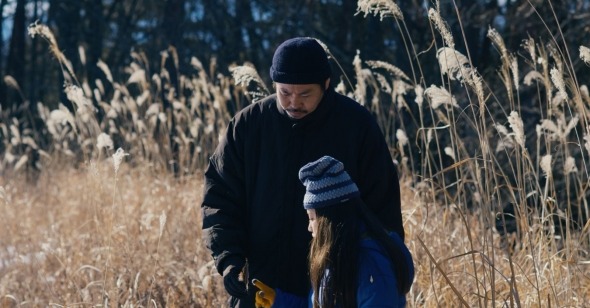Into the Woods
By Imogen Sara Smith
Evil Does Not Exist
Ryusuke Hamaguchi, Japan, Sideshow/Janus Films
In Ryusuke Hamaguchi’s Evil Does Not Exist, the forest is both a 21st-century threatened ecosystem and a fairy-tale wood steeped in mystery and dark magic. What starts out as an environmental parable, pitting respectful efforts to live in balance with nature against shortsighted corporate greed, turns into something far stranger and more disquieting. Hamaguchi’s films (Drive My Car, Asako I & II) have a tendency to take unexpected turns, but the latest—winner of the Grand Jury Prize in Venice—is especially unpredictable, luring usdown a path that leads further and further from the rationally explicable.
The film opens and closes with extended, smoothly floating traveling shots in which the camera looks up through wintry branches, an eerie effect that recalls the coffin’s-eye viewpoint in Carl Dreyer’s 1932 Vampyr. In between, there are scenes that glide along at the pace of a walk through the woods, and driving sequences where the camera is positioned at the back of the car watching the ribbon of road unfurl behind it. These fluid movements are often lopped off abruptly, and the music accompanying them suddenly stops, an effect that calls attention to its artifice. In its absence, sounds are heightened: the crunching of snow, the bubbling of spring water, the whining roar of a chainsaw. Many scenes are precariously balanced between tranquility and unease.
Patterns are repeated with variations, motifs are planted and redeemed. Delicate deer-tracks in the snowand the decaying skeleton of a fawn start a trail of references that leads up to a final, cryptic confrontation. The thorns of a Siberian ginseng tree, which a father warns his daughter about near the beginning, lacerate the hand of another woman near the end. The opening scenes that patiently observe Takumi (the quietly potent Hitoshi Omika) chopping firewood and filling jugs with spring water establish a peaceful routine, but also set up a later sequence, at once comic and psychologically complex, when he will perform the same actions with a pair of urban intruders as eager helpers.
Takumi is an odd-jobs man living in a cozy house in the woods with his young daughter, Hana (Ryo Nishikawa). They share an idyllic communion with nature, as he carries her piggyback through the forest, teaching her to identify trees and birds’ feathers. But there are certain silences that raise questions. What happened to Hana’s mother, who is seen in photographs around the cabin? Does Takumi’s habit of forgetting to pick her up from school indicate something more than absent-mindedness? He proves to be a deeply ambiguous character, charismatic in his Zen calm, physical skill, and knowledge of woodsy lore, but dropping unsettling clues that he might not be as pure a soul as he seems.
The rustic, unspoiled existence of Takumi and his neighbors in rural Harasawa is threatened by plans to set up a “glamping” site in the area. Representatives from the Tokyo-based company, a talent agency called Playmode, present their plans to the community in a long scene that starts to resemble an outtake from a Frederick Wiseman documentary. At first it is simply an amusing satire of smarmy corporate bullshit, with the two spokespeople responding to the locals’ concerns about an inadequate septic tank poisoning their water with “Thank you for your feedback” and standard talking points about how increased tourism will benefit the region. As it goes on, and the hostile crowd makes one stirring speech after another exposing the company’s shoddy planning and irresponsible disregard for risks of forest fires and polluted wells, I started to feel more and more sorry for the Playmode representatives. Takahashi (Ryuji Kosaka) and Mayazumi (Ayaka Shibutani) are hapless employees stuck in the firing line as their company goes through a bad-faith show of listening to the community. After appearing first as ciphers fronting for cheesy promotional PowerPoints, they turn into fully developed characters.
We get to know Takahashi and Mayazumi as they get to know each other during a long drive back to the region from Tokyo, as they talk about dating apps, marriage, and how they got into the sleazy talent-management industry. In a radical turn, Takahashi becomes infatuated with the idea of a simple life in nature and hopes to become the glamping site’s caretaker. He hero-worships Takumi, following him around as an eager wannabe apprentice, watching him effortlessly split wood with a single blow of the axe. This dynamic brings out something ever-so-subtly needling and passive-aggressive in Takumi, revealed in small absences of courtesy.
Evil Does Not Exist falls roughly into three acts: the first a quiet, detailed portrayal of a place and everyday life, the second a comedy about urbanites’ back-to-nature fantasies. (Aside from being a singularly ugly portmanteau word, “glamping” represents the desire for an experience of nature with none of the discomforts or inconveniences.) The third act is laced with poetry and horror. Omens appear: distant gunshots, black feathers floating in an icy pond, a drop of blood glistening on a thorn. As the mood grows more sinister, the images become more shiveringly beautiful. The sun, sinking through the trees, turns drifting woodsmoke into a luminous ghost enveloping Takumi’s cabin, as a public-address system plays a message about a lost child. The lanterns of a search party play through the dark forest like will-o’-the-wisps.
For all its carefully laid patterns, nothing in the film quite prepares you for the bizarre and enigmatic ending. Set in a misty, twilit field, the scene is visually constructed to resist any clear reading of what happens. Hamaguchi uses camera setups and editing to create the effect of a fragmentary folktale that frustrates logic with its gaps and disturbs with its inexplicable violence. What you’re left with is the sense of a forest spirit that is by no means benign, but that is as beyond good or evil just as it is beyond our understanding.
